Analysis of Offensive and Defensive Strategies in Maritime Terrorism
VerifiedAdded on 2022/01/20
|5
|1086
|228
Report
AI Summary
This report provides an analysis of offensive and defensive responses to maritime terrorism. It defines maritime terrorism and explores both short-term and long-term strategies. The offensive responses discussed include tactical intelligence operations, law enforcement, and actions against terrorist infrastructure. The defensive responses cover crisis management, prevention, trust creation, and negotiation. The report highlights the advantages and disadvantages of each approach, assessing the feasibility of success for both short-term and long-term solutions. The author emphasizes the importance of understanding the roots of maritime terrorism and the need for comprehensive strategies to ensure the safety of ships and individuals in the maritime space. References include works by Barnes, Haberfeld & Hassell, and Hoffman.
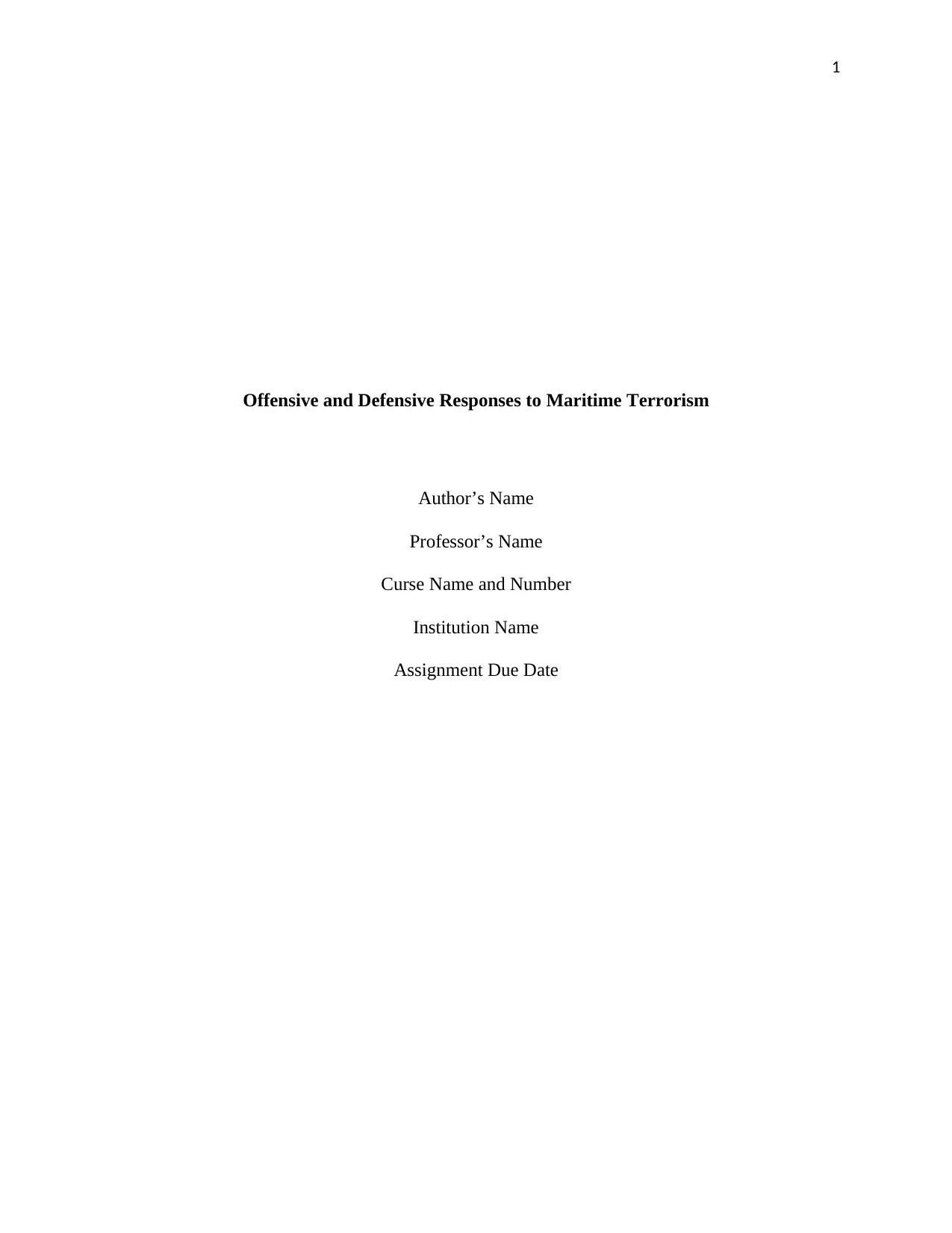
1
Offensive and Defensive Responses to Maritime Terrorism
Author’s Name
Professor’s Name
Curse Name and Number
Institution Name
Assignment Due Date
Offensive and Defensive Responses to Maritime Terrorism
Author’s Name
Professor’s Name
Curse Name and Number
Institution Name
Assignment Due Date
Paraphrase This Document
Need a fresh take? Get an instant paraphrase of this document with our AI Paraphraser
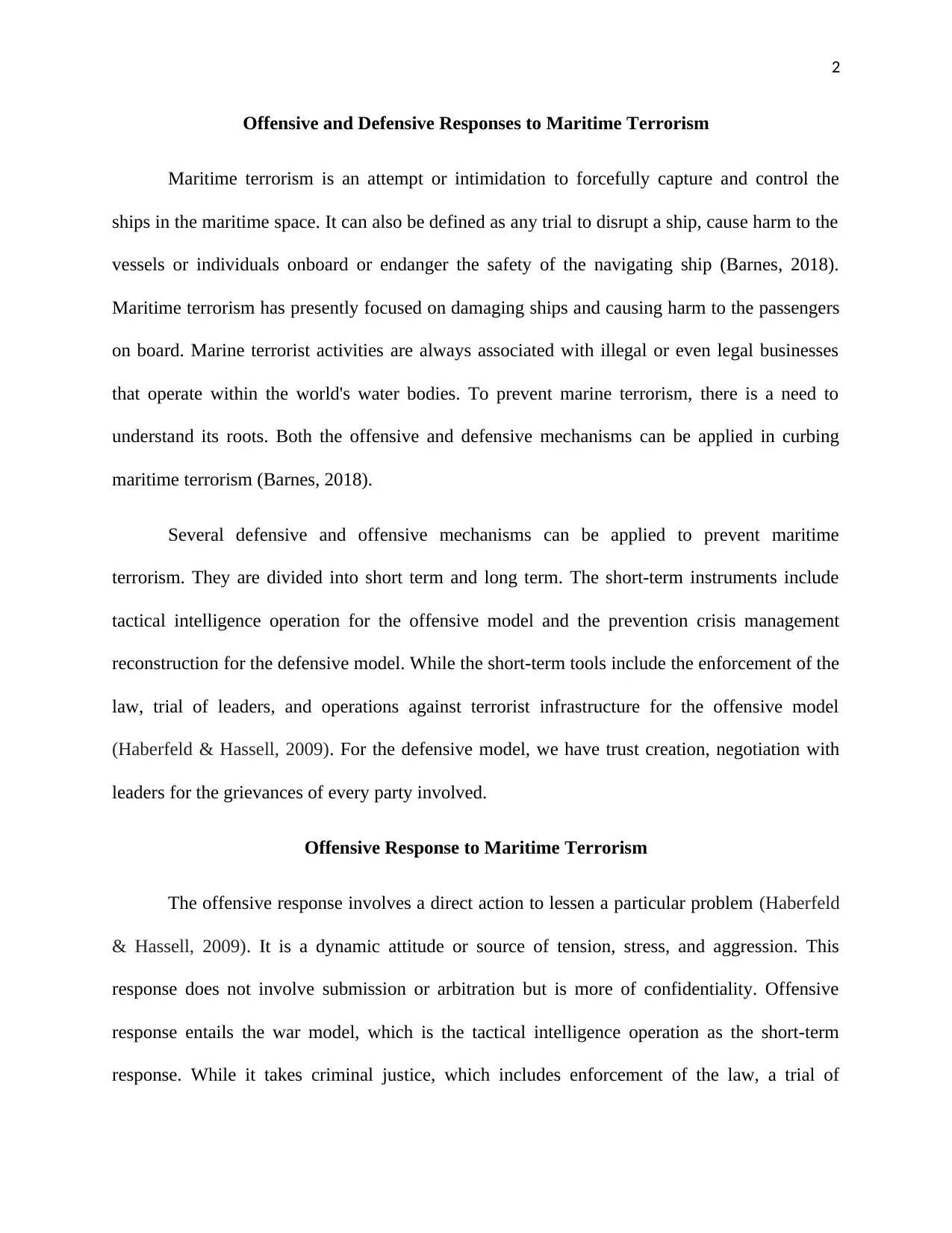
2
Offensive and Defensive Responses to Maritime Terrorism
Maritime terrorism is an attempt or intimidation to forcefully capture and control the
ships in the maritime space. It can also be defined as any trial to disrupt a ship, cause harm to the
vessels or individuals onboard or endanger the safety of the navigating ship (Barnes, 2018).
Maritime terrorism has presently focused on damaging ships and causing harm to the passengers
on board. Marine terrorist activities are always associated with illegal or even legal businesses
that operate within the world's water bodies. To prevent marine terrorism, there is a need to
understand its roots. Both the offensive and defensive mechanisms can be applied in curbing
maritime terrorism (Barnes, 2018).
Several defensive and offensive mechanisms can be applied to prevent maritime
terrorism. They are divided into short term and long term. The short-term instruments include
tactical intelligence operation for the offensive model and the prevention crisis management
reconstruction for the defensive model. While the short-term tools include the enforcement of the
law, trial of leaders, and operations against terrorist infrastructure for the offensive model
(Haberfeld & Hassell, 2009). For the defensive model, we have trust creation, negotiation with
leaders for the grievances of every party involved.
Offensive Response to Maritime Terrorism
The offensive response involves a direct action to lessen a particular problem (Haberfeld
& Hassell, 2009). It is a dynamic attitude or source of tension, stress, and aggression. This
response does not involve submission or arbitration but is more of confidentiality. Offensive
response entails the war model, which is the tactical intelligence operation as the short-term
response. While it takes criminal justice, which includes enforcement of the law, a trial of
Offensive and Defensive Responses to Maritime Terrorism
Maritime terrorism is an attempt or intimidation to forcefully capture and control the
ships in the maritime space. It can also be defined as any trial to disrupt a ship, cause harm to the
vessels or individuals onboard or endanger the safety of the navigating ship (Barnes, 2018).
Maritime terrorism has presently focused on damaging ships and causing harm to the passengers
on board. Marine terrorist activities are always associated with illegal or even legal businesses
that operate within the world's water bodies. To prevent marine terrorism, there is a need to
understand its roots. Both the offensive and defensive mechanisms can be applied in curbing
maritime terrorism (Barnes, 2018).
Several defensive and offensive mechanisms can be applied to prevent maritime
terrorism. They are divided into short term and long term. The short-term instruments include
tactical intelligence operation for the offensive model and the prevention crisis management
reconstruction for the defensive model. While the short-term tools include the enforcement of the
law, trial of leaders, and operations against terrorist infrastructure for the offensive model
(Haberfeld & Hassell, 2009). For the defensive model, we have trust creation, negotiation with
leaders for the grievances of every party involved.
Offensive Response to Maritime Terrorism
The offensive response involves a direct action to lessen a particular problem (Haberfeld
& Hassell, 2009). It is a dynamic attitude or source of tension, stress, and aggression. This
response does not involve submission or arbitration but is more of confidentiality. Offensive
response entails the war model, which is the tactical intelligence operation as the short-term
response. While it takes criminal justice, which includes enforcement of the law, a trial of
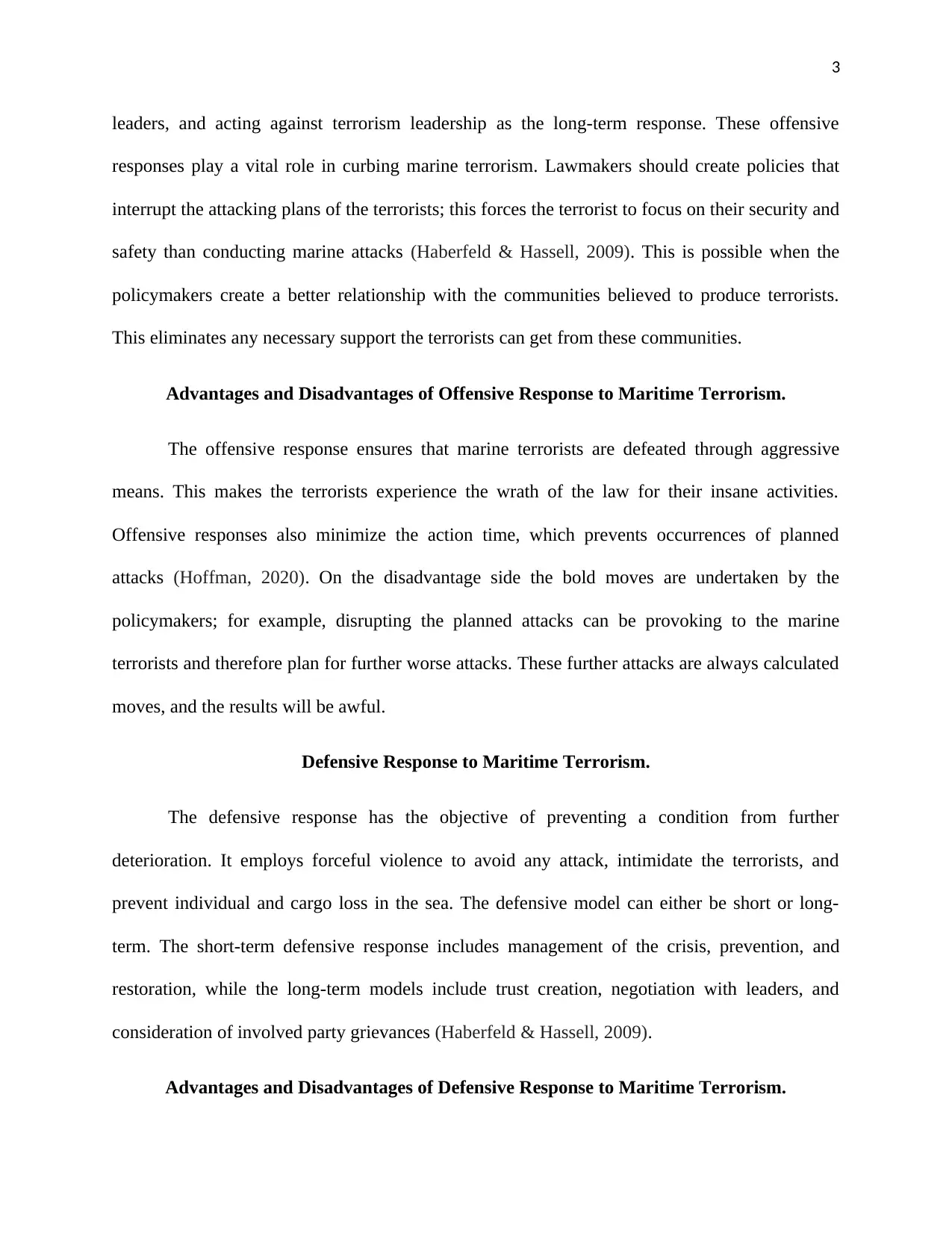
3
leaders, and acting against terrorism leadership as the long-term response. These offensive
responses play a vital role in curbing marine terrorism. Lawmakers should create policies that
interrupt the attacking plans of the terrorists; this forces the terrorist to focus on their security and
safety than conducting marine attacks (Haberfeld & Hassell, 2009). This is possible when the
policymakers create a better relationship with the communities believed to produce terrorists.
This eliminates any necessary support the terrorists can get from these communities.
Advantages and Disadvantages of Offensive Response to Maritime Terrorism.
The offensive response ensures that marine terrorists are defeated through aggressive
means. This makes the terrorists experience the wrath of the law for their insane activities.
Offensive responses also minimize the action time, which prevents occurrences of planned
attacks (Hoffman, 2020). On the disadvantage side the bold moves are undertaken by the
policymakers; for example, disrupting the planned attacks can be provoking to the marine
terrorists and therefore plan for further worse attacks. These further attacks are always calculated
moves, and the results will be awful.
Defensive Response to Maritime Terrorism.
The defensive response has the objective of preventing a condition from further
deterioration. It employs forceful violence to avoid any attack, intimidate the terrorists, and
prevent individual and cargo loss in the sea. The defensive model can either be short or long-
term. The short-term defensive response includes management of the crisis, prevention, and
restoration, while the long-term models include trust creation, negotiation with leaders, and
consideration of involved party grievances (Haberfeld & Hassell, 2009).
Advantages and Disadvantages of Defensive Response to Maritime Terrorism.
leaders, and acting against terrorism leadership as the long-term response. These offensive
responses play a vital role in curbing marine terrorism. Lawmakers should create policies that
interrupt the attacking plans of the terrorists; this forces the terrorist to focus on their security and
safety than conducting marine attacks (Haberfeld & Hassell, 2009). This is possible when the
policymakers create a better relationship with the communities believed to produce terrorists.
This eliminates any necessary support the terrorists can get from these communities.
Advantages and Disadvantages of Offensive Response to Maritime Terrorism.
The offensive response ensures that marine terrorists are defeated through aggressive
means. This makes the terrorists experience the wrath of the law for their insane activities.
Offensive responses also minimize the action time, which prevents occurrences of planned
attacks (Hoffman, 2020). On the disadvantage side the bold moves are undertaken by the
policymakers; for example, disrupting the planned attacks can be provoking to the marine
terrorists and therefore plan for further worse attacks. These further attacks are always calculated
moves, and the results will be awful.
Defensive Response to Maritime Terrorism.
The defensive response has the objective of preventing a condition from further
deterioration. It employs forceful violence to avoid any attack, intimidate the terrorists, and
prevent individual and cargo loss in the sea. The defensive model can either be short or long-
term. The short-term defensive response includes management of the crisis, prevention, and
restoration, while the long-term models include trust creation, negotiation with leaders, and
consideration of involved party grievances (Haberfeld & Hassell, 2009).
Advantages and Disadvantages of Defensive Response to Maritime Terrorism.
⊘ This is a preview!⊘
Do you want full access?
Subscribe today to unlock all pages.

Trusted by 1+ million students worldwide
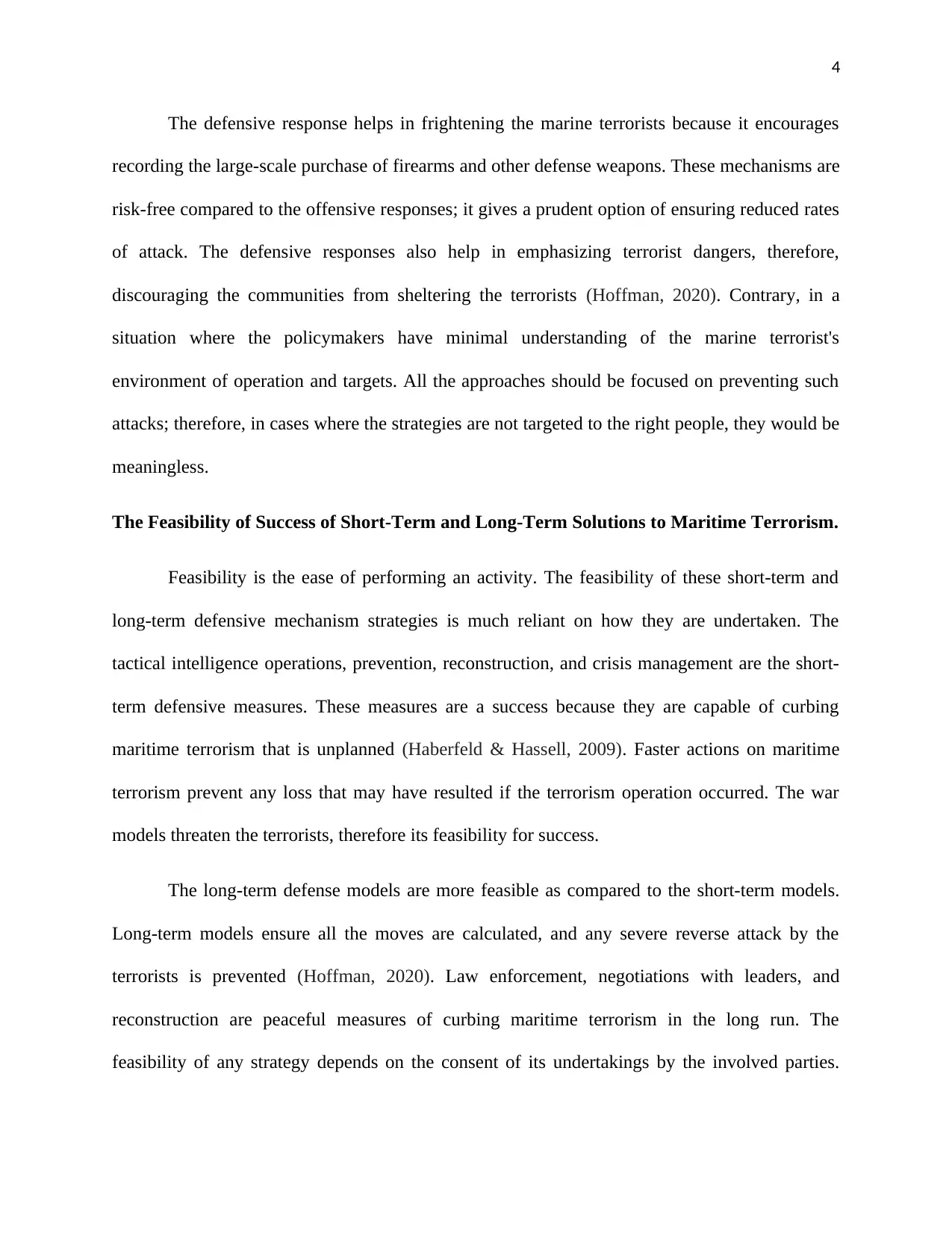
4
The defensive response helps in frightening the marine terrorists because it encourages
recording the large-scale purchase of firearms and other defense weapons. These mechanisms are
risk-free compared to the offensive responses; it gives a prudent option of ensuring reduced rates
of attack. The defensive responses also help in emphasizing terrorist dangers, therefore,
discouraging the communities from sheltering the terrorists (Hoffman, 2020). Contrary, in a
situation where the policymakers have minimal understanding of the marine terrorist's
environment of operation and targets. All the approaches should be focused on preventing such
attacks; therefore, in cases where the strategies are not targeted to the right people, they would be
meaningless.
The Feasibility of Success of Short-Term and Long-Term Solutions to Maritime Terrorism.
Feasibility is the ease of performing an activity. The feasibility of these short-term and
long-term defensive mechanism strategies is much reliant on how they are undertaken. The
tactical intelligence operations, prevention, reconstruction, and crisis management are the short-
term defensive measures. These measures are a success because they are capable of curbing
maritime terrorism that is unplanned (Haberfeld & Hassell, 2009). Faster actions on maritime
terrorism prevent any loss that may have resulted if the terrorism operation occurred. The war
models threaten the terrorists, therefore its feasibility for success.
The long-term defense models are more feasible as compared to the short-term models.
Long-term models ensure all the moves are calculated, and any severe reverse attack by the
terrorists is prevented (Hoffman, 2020). Law enforcement, negotiations with leaders, and
reconstruction are peaceful measures of curbing maritime terrorism in the long run. The
feasibility of any strategy depends on the consent of its undertakings by the involved parties.
The defensive response helps in frightening the marine terrorists because it encourages
recording the large-scale purchase of firearms and other defense weapons. These mechanisms are
risk-free compared to the offensive responses; it gives a prudent option of ensuring reduced rates
of attack. The defensive responses also help in emphasizing terrorist dangers, therefore,
discouraging the communities from sheltering the terrorists (Hoffman, 2020). Contrary, in a
situation where the policymakers have minimal understanding of the marine terrorist's
environment of operation and targets. All the approaches should be focused on preventing such
attacks; therefore, in cases where the strategies are not targeted to the right people, they would be
meaningless.
The Feasibility of Success of Short-Term and Long-Term Solutions to Maritime Terrorism.
Feasibility is the ease of performing an activity. The feasibility of these short-term and
long-term defensive mechanism strategies is much reliant on how they are undertaken. The
tactical intelligence operations, prevention, reconstruction, and crisis management are the short-
term defensive measures. These measures are a success because they are capable of curbing
maritime terrorism that is unplanned (Haberfeld & Hassell, 2009). Faster actions on maritime
terrorism prevent any loss that may have resulted if the terrorism operation occurred. The war
models threaten the terrorists, therefore its feasibility for success.
The long-term defense models are more feasible as compared to the short-term models.
Long-term models ensure all the moves are calculated, and any severe reverse attack by the
terrorists is prevented (Hoffman, 2020). Law enforcement, negotiations with leaders, and
reconstruction are peaceful measures of curbing maritime terrorism in the long run. The
feasibility of any strategy depends on the consent of its undertakings by the involved parties.
Paraphrase This Document
Need a fresh take? Get an instant paraphrase of this document with our AI Paraphraser
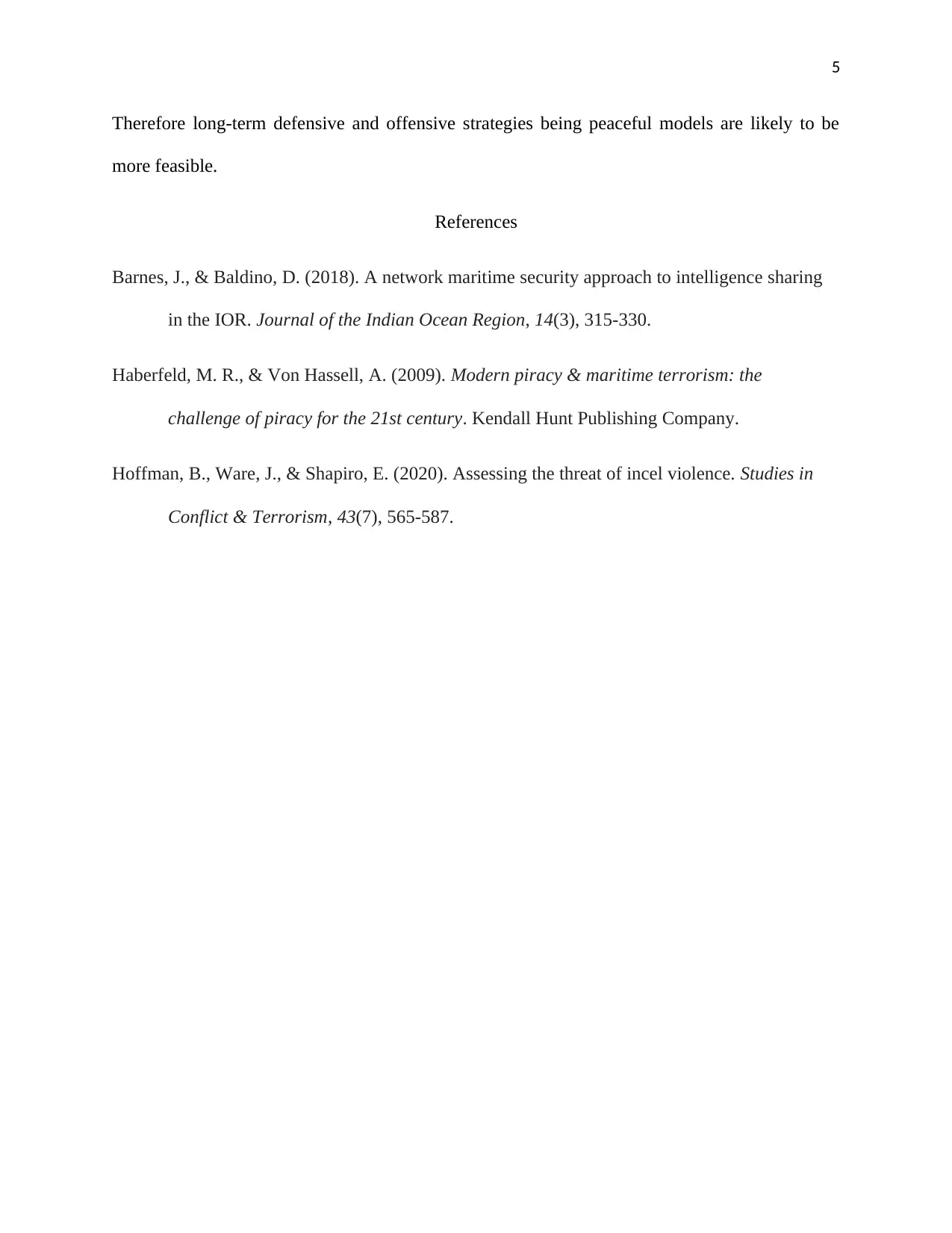
5
Therefore long-term defensive and offensive strategies being peaceful models are likely to be
more feasible.
References
Barnes, J., & Baldino, D. (2018). A network maritime security approach to intelligence sharing
in the IOR. Journal of the Indian Ocean Region, 14(3), 315-330.
Haberfeld, M. R., & Von Hassell, A. (2009). Modern piracy & maritime terrorism: the
challenge of piracy for the 21st century. Kendall Hunt Publishing Company.
Hoffman, B., Ware, J., & Shapiro, E. (2020). Assessing the threat of incel violence. Studies in
Conflict & Terrorism, 43(7), 565-587.
Therefore long-term defensive and offensive strategies being peaceful models are likely to be
more feasible.
References
Barnes, J., & Baldino, D. (2018). A network maritime security approach to intelligence sharing
in the IOR. Journal of the Indian Ocean Region, 14(3), 315-330.
Haberfeld, M. R., & Von Hassell, A. (2009). Modern piracy & maritime terrorism: the
challenge of piracy for the 21st century. Kendall Hunt Publishing Company.
Hoffman, B., Ware, J., & Shapiro, E. (2020). Assessing the threat of incel violence. Studies in
Conflict & Terrorism, 43(7), 565-587.
1 out of 5
Your All-in-One AI-Powered Toolkit for Academic Success.
+13062052269
info@desklib.com
Available 24*7 on WhatsApp / Email
![[object Object]](/_next/static/media/star-bottom.7253800d.svg)
Unlock your academic potential
Copyright © 2020–2025 A2Z Services. All Rights Reserved. Developed and managed by ZUCOL.